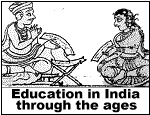The Agraharas
The History of Agraharas
by Dr. Jyotsna Kamat
First Online: May 01, 2003
Page Last Updated: December 07, 2024
Excerpted from author's forthcoming book "Education in Karnataka through the Ages"
Agraharas became the foremost educational institutions in southern India during the medieval period. They were group settlements of brahmins who formed a corporate body and administered all affairs of the agrahara, including education. The earliest agrahara in medieval Karnataka appears to be that of Talagunda or Sthanakundur (in present day Shimoga district). An inscription mentions that the ancestor of Mayurasharman (or Varman), the founder of the Kadamba dynasty, brought thirty-two learned brahmins from Ahichchatra and settled them in Sthanakundur, turning it into an agrahara (350 CE.). This shows that kings promoted learning by inviting scholars from outside, and this practice continued in later centuries. It is said that Mayurasharman granted 144 villages to the support of the agrahara.
Further details of this agrahara are available in an inscription from 1150 C.E. indicating that Talagunda continued as a famous center of education for eight centuries. There were forty-eight students and eight teachers of different subjects, such as the vedas, vedanta, prosody, rupavatara (grammar) and prabhakara (philosophy). Besides, there were arrangements to teach Kannada at the primary level (Kannadaksharashikshe). Provision was made for clothing (sire, or saree) for the teachers, students and the temple staff, and there were cooks who cooked food for all inmates.
Later, the Chalukyan king Vikramaditya VI invited learned brahmins from Tamil Nadu, and turned Nirgunda in Koguli province into an agrahara (agraharikritya) and donated it to the brahmins.
Queens of Karnataka also took a leading role in establishing the agraharas. Queen Kamaladevi, wife of the Kadamba king Shivachitta (see Kadambas) thought of founding an agrahara in Degamve (in present day Belgaum District) and told the king of her desire in the audience hall. According to an inscription, the king put the proposal before his council of ministers, which consulted one another, and finally accepted the proposal. The queen herself selected a number of Brahmins, who were well versed in different subjects. They hailed from different lands. This inscription gives an idea of how an agrahara came into existence and how enough care was exercised to recruit the right learned brahmins who could prove worthy of royal grants.
The agraharas imparted primary education, which was in the Kannada language. In one instance, the puranabhatta (teacher of the epics) read out the puranas in the evening and the rest of the day was utilized to teach children. The teacher was known as the akkariga or Karnatapandita. These teachers, who taught the reading and writing of the Kannada alphabet were village schoolmasters. However there were also other teachers who taught Nagara (Sanskrit), Tigula (Tamil) and Arya (Marathi) as per an inscription of 1290 C.E. It was required of boys to learn different languages, which enabled them to travel from one region to another, for reasons of trade, pilgrimage and learning.
In Narasimhapura agrahara of Belur, boys were taught the Rigveda and the Yajurveda. Some agraharas taught only parts (khandike) of the vedas. It is likely that the simpler prayers, invocation mantras and riks were taught to youngsters, followed by an introduction of padapatha (recitation of verses), sutras, and the recitation. An agrahara was typically composed of different vocations such as blacksmiths (kammara), carpenters (badiga ), goldsmiths (suvarnakara), security men (talara ), flower-men and farmers. Youngsters of all the families in the community received elementary education locally in their families and later through guilds.
Most of the agraharas had groups of villages under them and were closely connected with other educational institutions such as shales, mathas, brahmapuris, and ghatika, and in a real-sense could be called alma mater.
![]()
See Also:
- The Brahmins -- Potpourri of topics on the various brahmin communities of India; includes a number of pictures and a comprehensive list of priestly communities.
- References on History of Education in India

